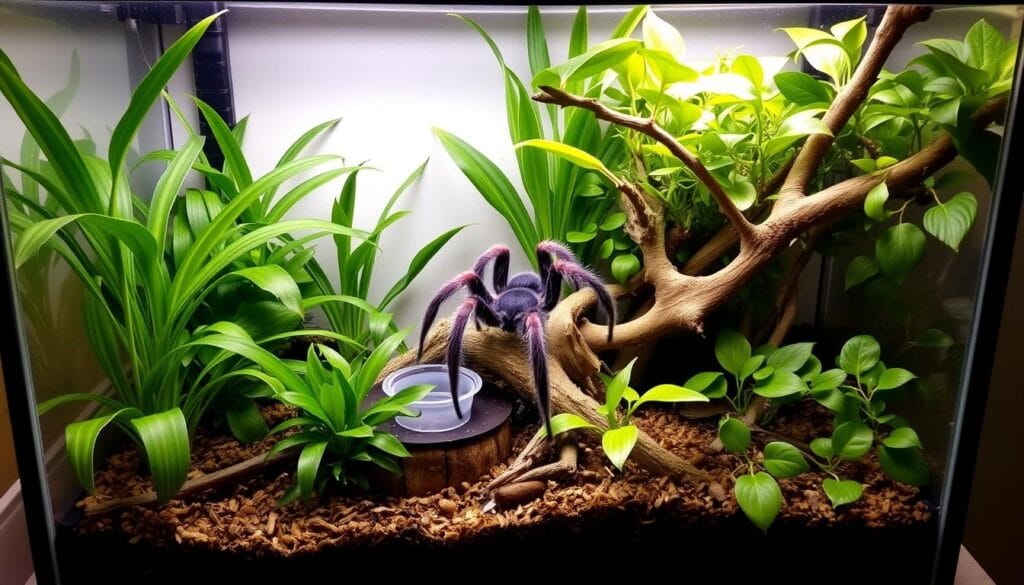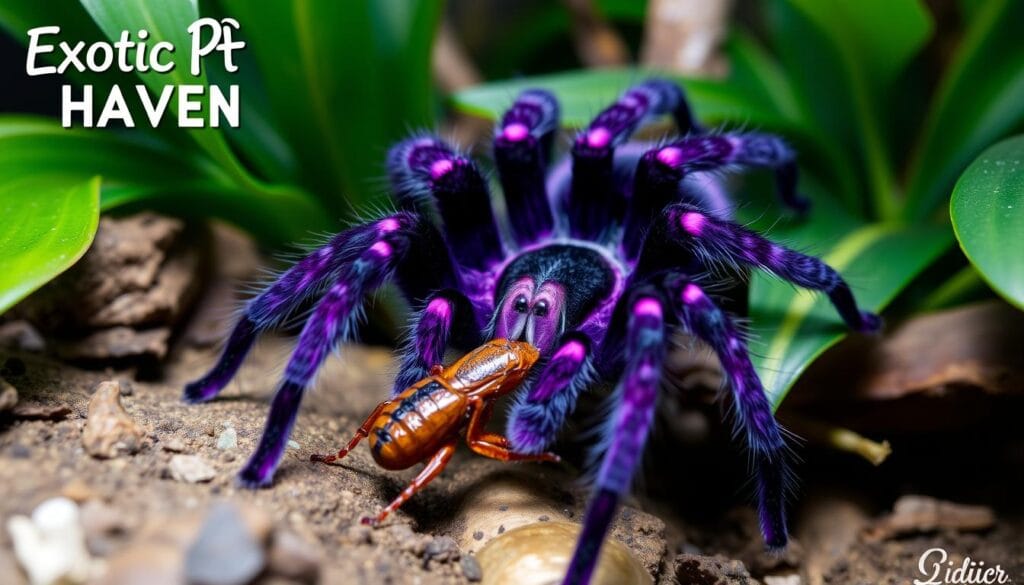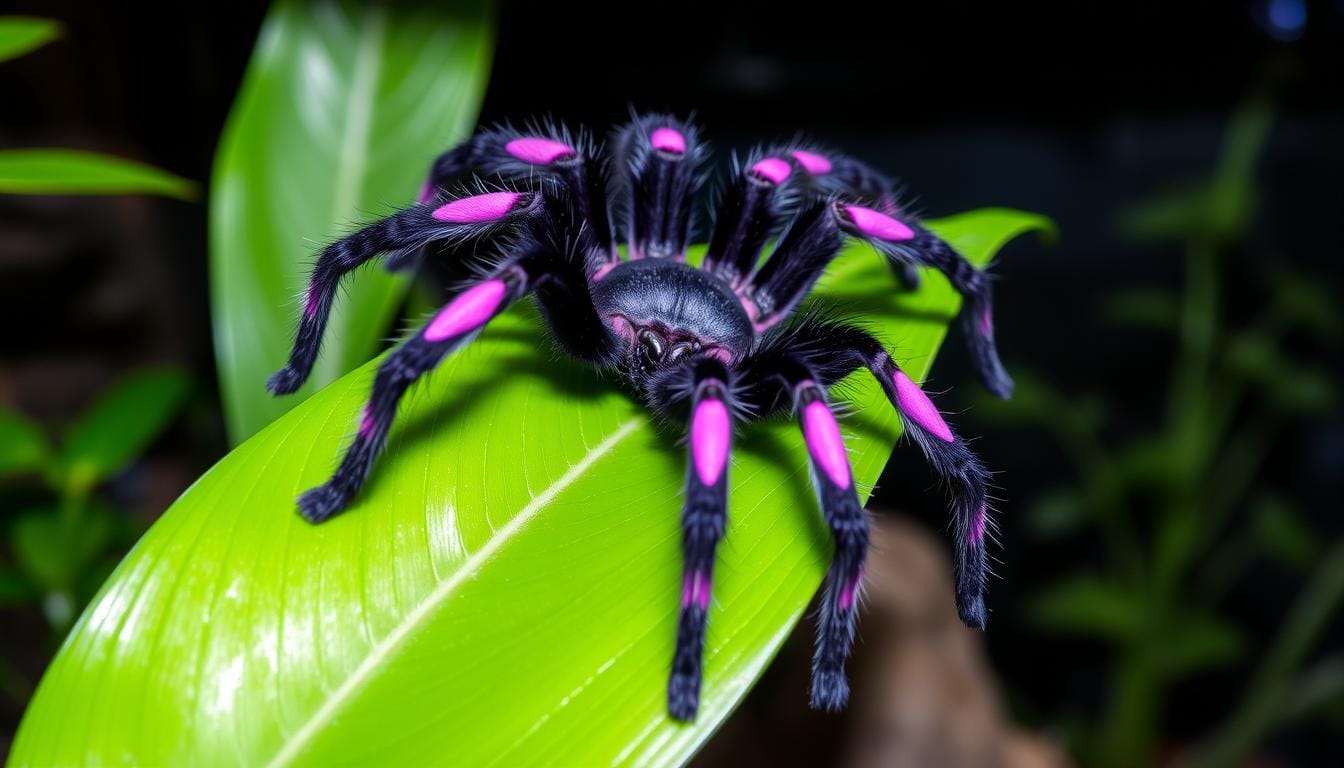Ever wondered why the purple pink toe tarantula is so captivating? These colorful spiders are more than just eight-legged creatures. They bring the vibrant ecosystems of South America into your home.
The purple pink toe tarantula, known scientifically as Caribena versicolor, is a remarkable tarantula species. They change dramatically as they grow. From blue spiderlings to metallic reds and greens, they offer a mesmerizing visual journey.
It’s important to understand their unique needs for the best care. These beautiful creatures can grow up to 5 to 6 inches long. They have fascinating characteristics that make them a favorite among spider enthusiasts.
Table of Contents
Introduction to the Purple Pink Toe Tarantula
Explore the world of the purple pink toe tarantula, a spider that fascinates many. It shows us the variety of tarantula habitats and behaviors.
Overview of the Species
The purple pink toe tarantula comes from Central and South America. It’s known for its unique look and calm nature. These spiders grow 5 to 6 inches long, making them a good size for many.
- Origin: Central and South American regions
- Size: 5-6 inches in length
- Classification: New World tarantula species
- Habitat: Tropical forest environments
Unique Characteristics
This tarantula is known for its beauty. It has a black body with mesmerizing green iridescence and pink leg tips. They love to climb and live in high places.
| Physical Trait | Description |
|---|---|
| Body Color | Black with green iridescence |
| Leg Coloration | Pink tips |
| Defense Mechanism | Urticating hairs |
Common Myths
“Not all tarantulas are aggressive – some are surprisingly gentle companions.”
Many people think tarantulas are scary. But purple pink toe tarantulas are not aggressive. They usually run away instead of fight. Their venom is not very strong, making them safe for many owners.
It’s important to know the truth about these spiders. They are calm and beautiful, which makes them interesting to many.
Setting Up the Habitat
Creating the perfect spider habitat for your exotic pet is a big job. It needs careful planning and lots of attention. The purple pink toe tarantula needs a special place that feels like its natural home.
Choosing the Right Enclosure
Your tarantula needs a big, open space to climb. Here are some important things to think about:
- Minimum 10-gallon tank with vertical orientation
- Secure side-opening design
- Height greater than width to accommodate climbing
- Ventilated walls to prevent stagnant air
Substrate and Décor Essentials
Building a natural environment is key:
- Use 2-3 inches of peat moss or fertilizer-free soil
- Include small logs and branches for climbing
- Add live plants to simulate natural ecosystem
Temperature and Humidity Management

| Parameter | Recommended Range |
|---|---|
| Temperature | 70-82°F |
| Humidity | 65-75% |
Pro tip: Use a hygrometer to check humidity. Mist the enclosure now and then to keep it right.
“A well-designed habitat is the key to a happy and healthy tarantula!” – Exotic Pet Experts
Feeding Your Purple Pink Toe
Caring for exotic pets like tarantulas means knowing their special diet needs. The Purple Pink Toe Tarantula needs certain foods to stay healthy and live long.
Diet Basics
Your Purple Pink Toe Tarantula loves to hunt and eats mostly live insects. The best foods for it are:
- Crickets
- Dubia roaches
- Mealworms
- Locusts

Feeding Schedule
How often to feed depends on the tarantula’s age and size:
- Young tarantulas: Feed every 2-5 days
- Adult tarantulas: Feed every 3-10 days
“Proper nutrition is key to maintaining a healthy exotic pet,” says arachnid expert Dr. Emily Rodriguez.
Signs of Proper Nutritional Health
Look for these signs of good nutrition in your tarantula:
- Regular molting
- Active hunting behavior
- Plump, healthy abdomen
Always take out any uneaten prey within 24 hours. This helps avoid stress and health problems for your pet.
Handling and Behavior
Exotic pets like the Purple Pink Toe Tarantula need careful handling. They require respect and gentle interaction. This ensures their well-being and your safety.
Safe Handling Techniques
Here are key tips for handling tarantulas:
- Always handle close to the ground to prevent falls
- Move slowly and predictably
- Use soft, clean hands
- Never grab or squeeze the tarantula
- Allow the spider to walk onto your hand naturally
Understanding Temperament
Purple Pink Toe Tarantulas are generally docile. But, they can get stressed with bad handling. They like to keep to themselves and are more watchful than aggressive.
“Patience and gentle approach are key when interacting with these delicate exotic pets.”
Recognizing and Managing Stress
| Stress Indicators | Management Strategies |
|---|---|
| Excessive hiding | Reduce handling frequency |
| Loss of appetite | Check habitat conditions |
| Unusual aggression | Minimize environmental disturbances |
During molting, avoid handling your tarantula. This stage is very vulnerable. It needs complete peace and minimal disturbance for successful skin shedding.
Common Health Issues and Care
Caring for exotic pets like purple pink toe tarantulas means knowing about health problems. These amazing arachnids are usually strong, but they can face certain health issues. It’s important to watch for these and take action early.
Recognizing Health Problems
Keeping an eye on your tarantula’s health is vital. Look out for signs like being very tired, not eating, or acting strangely. Mites can also be a big problem, so check your pet’s skin often. A care guide from experts can help spot health issues early.
Preventative Care Tips
Keeping your tarantula’s home right is key to avoiding health problems. Make sure the temperature is between 78 and 82°F, and the humidity is 65-75%. Clean the space often, change the substrate every four to six months, and always have fresh water. Good food and less stress help keep your tarantula healthy.
When to Seek Veterinary Assistance
Finding a vet for exotic pets can be hard, but it’s very important. If your tarantula has ongoing problems like trouble molting, losing weight, or acting odd, you might need a vet. Even though vet visits for tarantulas can cost, getting the right care keeps your pet happy and healthy.

